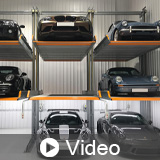
Guide to Mechanical Parking Solutions: Planning, Design, and Implementation – Stackers and Automated Parking Systems
KLAUS Multiparking America Inc. specializes in turnkey solutions, offering installation and maintenance for advanced Automated Parking Systems and Car Lift Stackers.
With our headquarters in New Jersey and regional offices across the USA, we deliver German-engineered solutions tailored for both self-park and valet operations. Our product portfolio includes: stackers, automated puzzle systems, pallets, turntables, and fully automatic systems. For over 34 years in the US, and more than 60 years globally through our parent company, KLAUS Multiparking GmbH, we’ve been a leader in space-saving and sustainable parking solutions. Our dedication to building long-term relationships and delivering exceptional customer service has made us a trusted partner for: commercial and residential developers, architects, engineers, and consultants, property management companies, and general contractors.
“Draw Today for Tomorrow” is more than a phrase—it embodies a forward-thinking mindset and serves as a call to action for architects, planners, and engineers to shape adaptable, sustainable environments by designing better spaces where people live, work, and thrive. As urban density increases and land availability decreases, architects, engineers, and developers are being challenged to rethink traditional approaches to parking. This course examines and highlights mechanical parking systems—including multilevel stackers, automated parking systems, parking pallets, and fully automatic solutions—as forward-thinking strategies that optimize space, reduce environmental impact, and enhance overall project value. Participants will explore how these systems can be successfully integrated into new construction, renovations, and adaptive reuse projects. The course covers key architectural and structural design considerations, system typologies, applicable use cases, and the measurable benefits of space efficiency and sustainability. By understanding the role of mechanical parking in future-ready design, attendees will gain valuable insights into maximizing usable building area, increasing revenue potential, and meeting sustainability goals—while delivering smarter, more livable spaces.
- Define mechanized parking systems and distinguish between key parking typologies, including appropriate building use cases and design scenarios for each, with a focus on space optimization and construction cost savings compared to traditional parking methods.
- Analyze architectural, structural, planning, and end-user experience criteria—including usability, accessibility, and operational efficiency—that influence system selection and integration in commercial, mixed-use, and residential developments.
- Examine how mechanical and automated parking systems support more efficient land use, enabling increased residential units, hotel rooms, amenity spaces, and other program areas, while enhancing design flexibility in both urban and suburban developments.
- Evaluate the broader project and environmental benefits of compact parking solutions, including opportunities to repurpose saved space for green areas, community features, or revenue-generating uses, as well as reduced development footprints, improved stormwater management, and decreased material consumption.





